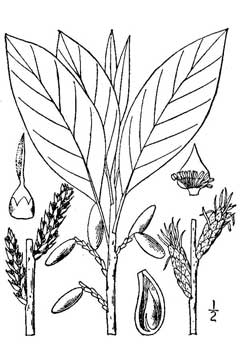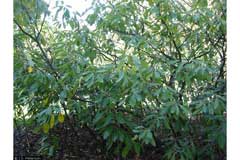 |
|
USDA-NRCS PLANTS Database / Britton, N.L., and A. Brown. 1913. An illustrated flora of the northern United States, Canada and the British Possessions. Vol. 1: 586. |
 |
| J.S. Peterson @ USDA-NRCS PLANTS Database |
Translate this page:
Summary
Physical Characteristics

 Leitneria floridana is a deciduous Shrub growing to 6 m (19ft 8in).
Leitneria floridana is a deciduous Shrub growing to 6 m (19ft 8in).
See above for USDA hardiness. It is hardy to UK zone 5 and is not frost tender. It is in flower in March, and the seeds ripen from May to July. The species is dioecious (individual flowers are either male or female, but only one sex is to be found on any one plant so both male and female plants must be grown if seed is required). . The plant is not self-fertile.
Suitable for: light (sandy), medium (loamy) and heavy (clay) soils. Suitable pH: mildly acid and neutral soils and can grow in saline soils.
It can grow in semi-shade (light woodland) or no shade. It prefers moist or wet soil.
UK Hardiness Map
US Hardiness Map
Synonyms
Plant Habitats
Woodland Garden Dappled Shade; Shady Edge; Bog Garden;
Edible Uses
References More on Edible Uses
Medicinal Uses
Plants For A Future can not take any responsibility for any adverse effects from the use of plants. Always seek advice from a professional before using a plant medicinally.
None known
References More on Medicinal Uses
The Bookshop: Edible Plant Books
Our Latest books on Perennial Plants For Food Forests and Permaculture Gardens in paperback or digital formats.

Edible Tropical Plants
Food Forest Plants for Hotter Conditions: 250+ Plants For Tropical Food Forests & Permaculture Gardens.
More

Edible Temperate Plants
Plants for Your Food Forest: 500 Plants for Temperate Food Forests & Permaculture Gardens.
More

More Books
PFAF have eight books available in paperback and digital formats. Browse the shop for more information.
Shop Now
Other Uses
Wood
Wood - very light, soft, close grained. The layers of annual growth are hardly distinguishable[82]. This is one of the lightest known woods, it weighs about 12½lb per cubic foot, is lighter than cork and is used for floats etc[1, 46, 61, 82, 235].
Special Uses
References More on Other Uses
Cultivation details
Requires a moist lime-free humus-rich soil[200], succeeding in badly-drained soils[182]. Plants grown in Britain tolerate drier conditions than their native habitat, but they still require plenty of moisture[11]. Plants are hardy as far north in America as Boston, Massachusetts[1]. They are unlikely to be fully hardy in all parts of Britain. Plants produce suckers[182]. Vegetative reproduction is predominant, forming large clones from adventitious buds on shallow roots[270]. Dioecious, male and female plants must be grown if seed is required.
References Carbon Farming Information and Carbon Sequestration Information
Temperature Converter
Type a value in the Celsius field to convert the value to Fahrenheit:
Fahrenheit:
The PFAF Bookshop
Plants For A Future have a number of books available in paperback and digital form. Book titles include Edible Plants, Edible Perennials, Edible Trees,Edible Shrubs, Woodland Gardening, and Temperate Food Forest Plants. Our new book is Food Forest Plants For Hotter Conditions (Tropical and Sub-Tropical).
Shop Now
Plant Propagation
The seed germinates better if it is given 3 months cold stratification so is probably best sown in the autumn in a cold frame. The seed can also be sown in late winter in a greenhouse but the germination is variable[78]. Prick out the seedlings into individual pots as soon as they are large enough to handle. Young plants should be overwintered in a greenhouse for their first year and can then be planted out in late spring after the last expected frosts[78]. Give some winter protection from the cold for their first year outdoors. Cuttings of half-ripe wood, July/August in a frame[113]. Division of suckers in the dormant season[113, 200].
Other Names
If available other names are mentioned here
Native Range
NORTHERN AMERICA: United States (Missouri (southeast), Arkansas, Florida, Georgia (south), Texas).
Weed Potential
Right plant wrong place. We are currently updating this section.
Please note that a plant may be invasive in one area but may not in your area so it's worth checking.
Conservation Status
IUCN Red List of Threatened Plants Status :

Growth: S = slow M = medium F = fast. Soil: L = light (sandy) M = medium H = heavy (clay). pH: A = acid N = neutral B = basic (alkaline). Shade: F = full shade S = semi-shade N = no shade. Moisture: D = dry M = Moist We = wet Wa = water.
Now available:
Food Forest Plants for Mediterranean Conditions
350+ Perennial Plants For Mediterranean and Drier Food Forests and Permaculture Gardens.
[Paperback and eBook]
This is the third in Plants For A Future's series of plant guides for food forests tailored to
specific climate zones. Following volumes on temperate and tropical ecosystems, this book focuses
on species suited to Mediterranean conditions—regions with hot, dry summers and cool, wet winters,
often facing the added challenge of climate change.
Read More
Expert comment
Author
Chapm.
Botanical References
11200270
Links / References
For a list of references used on this page please go here
Readers comment
| Add a comment |
|
If you have important information about this plant that may help other users please add a comment or link below. Only comments or links that are felt to be directly relevant to a plant will be included. If you think a comment/link or information contained on this page is inaccurate or misleading we would welcome your feedback at [email protected]. If you have questions about a plant please use the Forum on this website as we do not have the resources to answer questions ourselves.
* Please note: the comments by website users are not necessarily those held by PFAF and may give misleading or inaccurate information.
To leave a comment please Register or login here All comments need to be approved so will not appear immediately.
|
Subject : Leitneria floridana
|
|
|
|